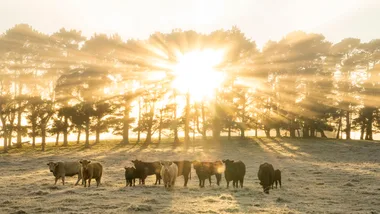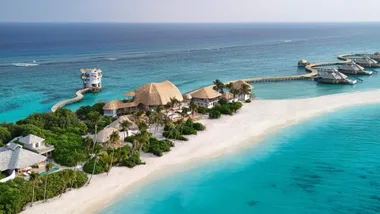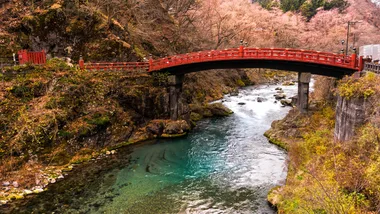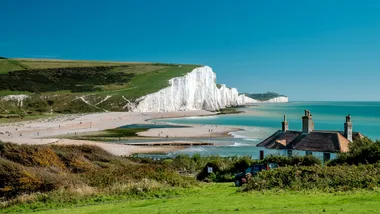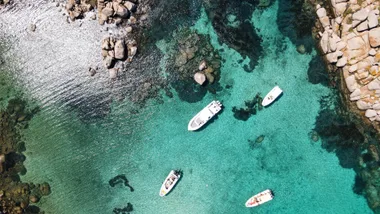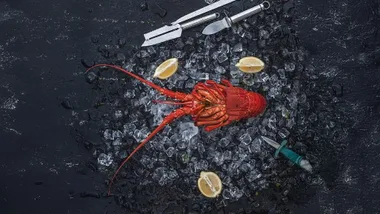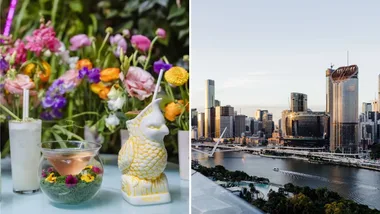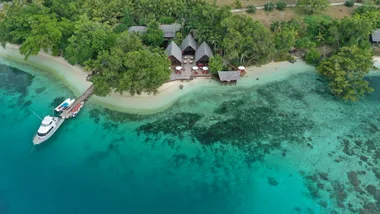There’s a moment, hiking above Norwood Estate, when it all comes together. Terraces of manicured tea shrubs are carved into steep storybook hills. Tulip trees glow vermillion, and huge, pale angel’s trumpet blooms droop into the dusk. Tea pickers, dressed in lurid prints and tartans, descend the trails with high bundles on their heads. These women pick 16 kilos – two leaves and a bud at a time – every day. Beautiful faces are still and serious until a joke sets off peals of laughter that reveal hard work and missing teeth. They wave and smile.
It’s a slow-motion glimpse into a time-warp idyll. Walking up and up, listening to our guide share his botanical knowledge, the history of these hills, is dreamy. (Plan: retrace these steps with headphones. This scenery deserves its own obscure personal soundtrack.) Finally, it’s cool enough to enjoy the climb and the fragrance of a tea plantation at dusk, but what nobody expects is the killer view that appears suddenly over a crest. The sun is setting behind Adam’s Peak – an almost corny moment of shocking beauty that does not photograph well on a phone. Best to just stand and gawp and marvel at the next surprise: the small table set with linen, silverware and high tea, the white and gold teapot, the backlit tower of tiny sandwiches and cakes. After all the perfect moments, this is the moment: freshly brewed tea and scones, with homemade hibiscus jam, are waiting for us in the Mad Hatter middle of perfect nowhere. And if this is our first sunset in Sri Lanka, the bar has been set very high. This is not going to be India-lite, but something completely different.

A view of Castlereagh Reservoir from the tea terraces
So why Sri Lanka now? As a holiday destination it scratches the same itch as Myanmar: off-piste and only recently explored by folk who appreciate sheets with the right thread count. After so much hardship – a 26-year civil war that ended in 2009, a devastating tsunami in 2004 – the sense of confidence and vigour is infectious, particularly since a change of government last year. On my first visit, in 1987, such rugged reincarnation was nowhere on the horizon.
The backpacking hotspot of the ’80s has resurfaced in peacetime with a fresh take on gracious hospitality, with boutique hotels and small-scale resorts. The dozy service and dreadful roads that I recalled aren’t entirely a thing of the past, but they are more readily avoided. New freeways linking Galle, Kandy and Colombo have halved driving times, though elsewhere challenging terrain and years of neglect mean criss- crossing the island takes hours. A time-poor traveller’s best friend is Cinnamon Air, whose small fleet of seaplanes connects beauty spots with scheduled and charter flights. Cashed-up, grown-up backpackers are returning with good reason.
The colonial mansion, or wallawwa, repurposed as boutique hotel, is very fashionable here. Properties such as Tintagel Colombo and Casa Colombo in the capital and Tamarind Hill in the south, afford us the opportunity to behave like spoilt imperialists, with clear 21st-century consciences. But for proper time travel, head north to Ceylon Tea Trails.

Ceylon Tea Trails’ Norwood bungalow
Twenty-five minutes after take-off at Colombo’s Bandaranaike International Airport, our Cessna 208 Amphibian lands dramatically in Bogawantalawa Valley on Castlereigh Reservoir flanked by the emerald tea terraces of the central highlands. On working tea estates around us are the five restored tea planters’ bungalows that form Ceylon Tea Trails. Ten years ago, when the civil war was still raging and few would dream of investing heavily in tourism, Dilmah Tea founder Merrill Fernando launched Tea Trails and set the standard for the island’s upmarket hospitality. The recently opened fifth bungalow above the Dunkeld tea factory is billed as “the best room in Sri Lanka”.
The bungalows, each uniquely dreamy and romantic, are linked by walking trails and an invisible net of high tea and timely cocktails. My stay at Norwood, a six-bedroom 1950s home with deep sofas and a sapphire pool, sets off a personal episode of Who Do You Think You Are? I didn’t know how much I needed my own manager, chef and butler until Norwood. Spacious rooms have names rather than numbers. No keys necessary. We are welcome to pour that gin and tonic (for medicinal purposes – damn malaria) any time we like. But the ever-present, ever-polite staff appear unobtrusively before the notion of a G&T develops into a thirst.
The tradition of bed tea might be the thing I miss most on departure. Bedside bell, tea of choice, butler service on waking. Heaven. A full English breakfast after a hike or bike ride would be fine, but the Sri Lankan breakfast – red and white string hoppers, chicken curry, dahl, banana-flower curry, seeni sambol And more – is so much better suited to the climate. And more tea.

Breakfast spread at Ceylon Tea Trails
The soundtrack at breakfast on the terrace at Norwood is music from the village below, local tunes broadcast with the tinny mono-echo of a PA system playing old vinyl mixed with church bells, cars, birds, and something else. Perhaps it’s the sound of giant bamboo growing at the rate of a foot per day. This is a place of lush possibility.
The region was originally planted with cinchona, the tree from which quinine was brewed. This was replaced with coffee and, when that failed after a plague in the late 1860s, tea took over and quickly, broken orange pekoe became the country’s major export.
I didn’t fight the temptation to become a tea nerd. Think wine aficionado, but sober and smugger. (Silver-tip tea after lunch is 10 times the price of regular black tea, and worth it, opines this newly minted tea bore.) Tea infuses everything from our bath menu to the crème brûlée. By the time we finish the tour of Dunkeld tea factory, I’ve become a two-leaves-and-a-bud expert.
The tea ceremony sets the pace for this holiday. The past and “the polite” resonate in our misty-hilly views, and the quiet service. Shoe-polishing, the carefully explained menu choices before each meal, the laundry that disappears and returns perfectly pressed, the gentle inquiry about our day – so polite. A day might unfold as breakfast at Norwood, a walk or ride to the Castlereagh bungalow for lunch and a swim, perhaps even a row across the millpond-green reservoir. For a few days, all of this is achievable. My reservoir. My kayak. My tea empire.
The Buddhist shrines on the road between estates have a shabby dignity. There’s some almost Vegas-like pizzazz in their LED lights, foil ornaments and plastic flowers, but it’s underpinned by a certain stillness. Often ours are the only recognisably foreign dusty shoes at the threshold, the only evidence that strangers are passing through.

Statues at a Buddhist temple along Matara Road in Galle
The four- to five-hour road trip from the Hatton highlands to Galle on the south coast may have dragged us, groaning, through the 20th century, but I can highly recommend bypassing all that for the quick scenic seaplane route to the future, at Tri Lanka. We land on Koggala Lake, a big cup of photosynthetic textures in a spectrum of battery-acid green. The rocks and crocs are just entertaining enough on the 10-minute boat ride from our landing spot. Opened in November last year, Tri Lanka is the quixotic experiment of two lion-hearted non-hoteliers. Lara Baumann and Rob Drummond greet our boat, looking like members of Gwyneth Paltrow’s book club. Waving from their very own wharf, they’re a dream couple in their early forties. He’s a bearded British Hugh Jackman, with bare brown feet and a great collection of photography books in his beautiful new library. She’s a diplomat’s daughter of German descent who designs all the enviable jewellery she’s wearing. Baumann is calm and cool in the midday sun despite being heavily pregnant because she’s one of Sri Lanka’s pre-eminent yoga teachers. Well, of course she is.
I’m ready to hate these people, but they have actually done the thing most of us talk about after 20 years of hard labour and a few wines: they bought a chunk of land on the south coast of Sri Lanka and have built an architecturally interesting retreat with Ayurvedic-inspired food, yoga classes and massages. And really good cocktails.
Built in the middle of a former cinnamon plantation, with lake views from every part of the property, Tri Lanka eschews butlers and tradition for more millennial comforts. For particular folk who like to roll “ethical”, “sustainable” and “footprint” into the one sentence, Tri Lanka has special appeal, if not entirely reliable air-conditioning. Designed by Shanghai-based ecological architect Raefer Wallis, the property has 14 guestrooms, with edible roof gardens on villas and living walls surrounded by banyan and cashew trees, and with ginger, cinnamon, lemongrass and passionfruit thriving on every surface. The villas radiate from a four-storey water tower clad in cinnamon twigs and housing three guestrooms (cheaper, great views). It’s something of a folly, but after the climb up the steep spiral stairs for drinks at sunset, it makes bonkers sense.

Tri Lanka from Koggala Lake
Utterly crisp and modern, there’s a respectful nod to traditional architectural vernacular, and all building materials are sourced locally. Recycled timbers, granite flagstones, green granite in the bathrooms, red gravel paths linking the buildings – the combination is as pleasing as the last five minutes of Baumann’s yoga class. While still bent into a hot pretzel, in a jackwood breezeway clad in cinnamon sticks, I’m reminded that only yesterday I was managing my staff, on my tea plantation, and possibly writing about it on my Remington typewriting machine. Exhausting.
All eye-rolling cynicism aside, the classes and treatments at Tri Lanka reflect Baumann and Drummond’s exacting standards. They’ve employed like-minded folk, so every assisted stretch comes with a story. Yoga isn’t offered just to tick a millennial luxury travel box – Baumann is a yoga teacher who just happens to run a hotel. The practitioners look like hipster guests passing through. Not standard five-star staff, but cool flaky folk who fit into this quirky scene.
They’ve imported Neil Wager – a British chef with stints at the remote luxe lodges of Nihiwatu on the Indonesian island of Sumba, and Song Saa Private Island off the Cambodian south coast under his belt – to crack a menu that applauds local produce, tradition and Ayurvedic wellness. If the poolside menu is not yet entirely successful, Wager warms to the task of building a dinner story. A beetroot curry, for example, as pretty and witty as it is delicious, is inspired by the contents of lunchboxes brought every day by the crews that built the resort. This is bright cooking, conceptually and visually, served on handmade, stealable crockery, not the fine china of Tea Trails.
It’s difficult but worthwhile to leave the resort. A 30-minute drive to the walled fort at Galle delivers Dutch and English churches, and jewellery shops and markets. For early risers, a visit to the fish markets on the beach when the fishermen return with their haul is a must. Whole yellowfin tuna rest, like giant Christmas hams, in the cross-sectioned trunk of a felled tree. I know people like refrigeration and not too much bloodshed at their fish markets, but this place has everything: leaky boats, nests of nets and a slow-moving 1.5-metre monitor lizard, just moseying through.

The cinnamon-clad water tower at Tri Lanka
A roadside breakfast on the way to the markets is a treat. Every buoyant society cultivates an essential fast food best enjoyed at three in the morning, and any time thereafter. Sri Lanka’s versions are called “short eats”. String hoppers – the island’s ubiquitous lacy rice-noodle pancakes – are ideal for scooping up fresh coconut sambol and kiri hodi, Maldivian cured fish in coconut-milk gravy. At Jothipala Tea Room, a roadside shack, they steam hoppers in the dark for the fisherman working across the road. Why are these the most delicious of all the hoppers we try? Resort kitchens can try, but the real thing just tastes different. By the fort wall near the fish market, a small cart serves kurakkan (red millet) porridge in a cup and a green gotu kola drink (rocket, kale mukunuwenna) – tastes that no resort menu can capture.
At the growers’ market in Galle in the newer part of town spice shops sell dried squid and heritage red rice, curry leaves and real cinnamon – not filthy cassia bark. The Ayurvedic dispensaries are busy and fascinating, frequented by locals and photographed by tourists.
A little more than half an hour’s drive east of Galle, on a cliff above the Indian Ocean, the Fernando family’s luxury travel arm, Resplendent Ceylon, opened a 40-villa retreat on five over-manicured hectares in late 2014. Resplendent’s managing director, Malik Fernando, describes Cape Weligama as having “all the privacy of a generous family home, with the services of a five-star hotel”. Alongside the family’s Ceylon Tea Trails, it’s part of an ambitious plan to create a string of luxe travel experiences on the island. Wild Coast Tented Lodge, near Yala National Park, is due to open at the end of the year, offering upmarket camping and leopard- spotting. Following that will come luxury lodges near the UNESCO World Heritage site of Sigiriya, due to open in 2017, and then Red Rocks Beach Camp in the eastern harbour city of Trincomalee the following year.

Freshly picked tea leaves
Though the villas at Cape Weligama are named after famous explorers of the region, guests are prone to getting lost in the maze of luxurious walls and pools, and often rely on the kindness of butlers for safe return. Lovely echoes of Tea Trails hospitality resonate with the butler (bearing flashlight and map), the laundry basket and in-room treatments. But the scale is at odds with the intimacy of Tea Trails.
The two-storey villas could house an extended family reunion with ease. The villas all have direct access to a sizeable pool. Each Master Room bathroom is as large as my first apartment, with a steam room and a massage table hiding in a closet. After a day of whale-watching, scuba-diving and getting horribly lost on the way back from the clam-bake lunch, my bathroom is transformed into a spa for a 90-minute spice massage with a poultice of, well, basically every spice and tea we’ve consumed so far. Perhaps a gigantic bathroom is a good thing.
This property is vast enough to lose your mother-in-law at that suggested family reunion, but it dwarfs guests with a glamorous scale usually seen on reality television. No surprise, then, when a film crew from the French version of The Bachelor is seen traipsing from pool to bar to clifftop, filming sobbing French girls. Dogs and peacocks guard an eerie temple called Yatagala Raja Maha Viharaya between Galle and Weligama. Atop a long flight of stairs, this 2,300-year- old temple, wedged between huge boulders, has been swept tidy by monks for hundreds of years. Again, our shoes left on the stairs are the only evidence that time or tourists have broken the spell. The views from here, over the rice paddies and back to the coast, perfectly bookend that first sunset view of Adam’s Peak.
Why Sri Lanka now? Since seaplanes have made this a no-brainer, go for the time travel, the food, the “polite”, the tea leaves breaking against your thighs as you walk up and up, back to something old and lost. It does actually photograph well on your phone, but that’s nothing like the experience of being here.
GETTING THERE
Singapore Airlines flies from Sydney, Melbourne, Adelaide, Perth and Brisbane to Singapore, and SilkAir flies from Darwin, with a daily flight to Colombo.
Malaysia Airlines, Cathay Pacific and Thai Airways fly from select Australian cities to Colombo via their Asian hubs.
Cinnamon Air operates three planes – two of them seaplanes – with daily scheduled flights and charters from Colombo’s Bandaranaike International Airport to a range of regional airports and scenic spots. cinnamonair.com
WHERE TO STAY
Ceylon Tea Trails
Five historic tea planters’ bungalows in the central highlands, connected by walking trails and staffed by a crack team of butlers and chefs. Rooms from $680, including all meals and drinks, afternoon tea, pre-dinner cocktails and the Tea Trails Experience (factory tour, guided walk and tea tasting). Bogawantalawa Valley, +94 11 774 5700, teatrails.com
Tri Lanka
Promoted as an environmentally sustainable luxury resort, Tri is located on a 2.5-hectare lakefront property, 30 minutes’ drive east of Galle. Lake Suites cost from $474, rooms in the water tower cost from $343, both including breakfast and dinner (or lunch). Koggala Lake, Galle, +94 77 748 5132, trilanka.com
Cape Weligama
This south-coast resort has 40 villas set in five hectares of garden, about 40 minutes’ drive east of Galle. Villas cost from $450, including breakfast, laundry, minibar, afternoon tea and a daily activity, from market tours to paddleboarding. Abimanagama Rd, Weligama, +94 11 774 5700, capeweligama.com
WHERE TO SHOP
Laksala
This state-run chain of souvenir shops stocks teas, spices, crafts, jewellery and leather goods – a one-stop gift shop for the traveller who’s not an expert in rare gems. 74 Sea St, Galle, +94 91 2222783, laksala.gov.lk
Anuradha Ceramics
This is where you’ll find the traditional handcrafted pottery used at Tri Lanka. 2-15, Lvl 2, Majestic City, Colombo, +94 11 259 9861, anuradhaceramics.com
Barefoot
Great for textiles, clothes and homewares. 41 Pedlar St, Galle Fort, +94 91 2226299, barefootceylon.com
Yasiru Spice Shack
Possibly the best place to buy real cinnamon and saffron. Shop 1, in front of the Old Dutch Market, Matara Rd, Galle.

